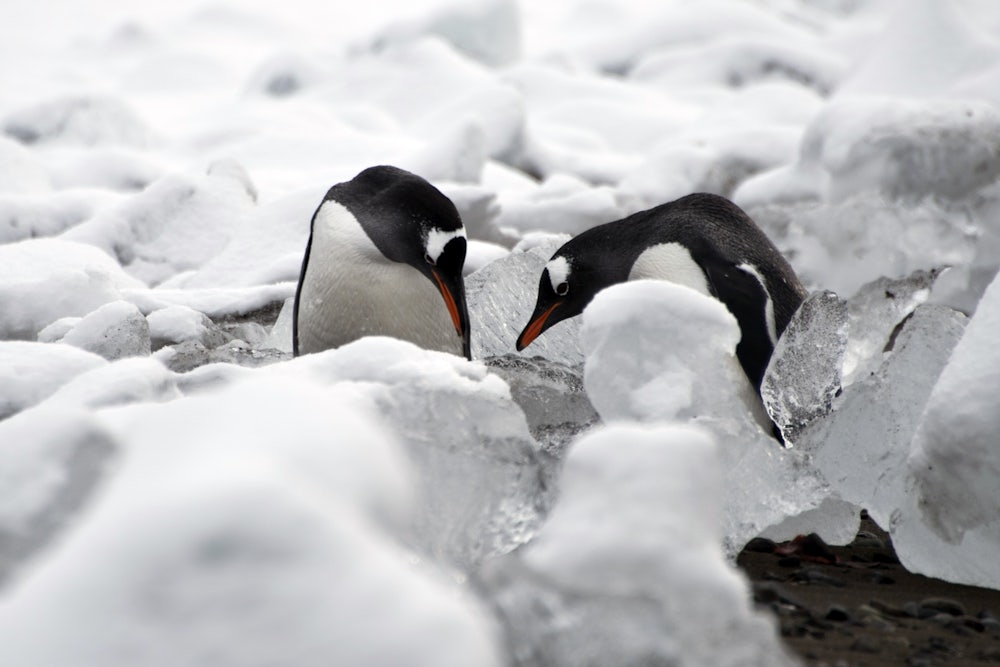I’m trying to remember what I thought about Antarctica before I came here. For the most part, I didn’t think about it at all. It is just plain remote. From the other side of the world, in Christchurch, New Zealand, it is another eight hours due south by plane to the main U.S. base, McMurdo, and then another three hours from there to the South Pole.
I came to the coldest place on Earth to hunt for information about global warming, but I was unprepared for the continent itself. For example, I didn’t know that the land area is half again as large as the United States. Or that 90 percent of all the ice in the world is here—which means, among other things, that there is really no comparison between this place and the Arctic. Antarctica is larger, more isolated, more important in the global ecosystem—and much colder.
You don’t expect a continent at the “bottom” of the world to have an altitude three times higher than any other continent. When I stepped out of the ski plane at the Pole, my awareness was divided between the 56-degree-below-zero weather and the dizziness at being at almost 10,000 feet. The altitude of the enormous polar plateau is due primarily to the ice that is almost two miles thick. Although its ice and snow contain 70 percent of all the fresh water on earth, Antarctica gets so little precipitation that it is classified as the world’s largest desert. And while the continent goes dark for six months in the winter, it still receives more sunlight during its six-month-long summer day than the equatorial regions receive in an entire year. Yet all that light creates virtually no surface heat, because most of it is reflected right back up into space. For anyone caught in that crossfire of whiteness, sunglasses are a medical necessity.
The ice shelf expands in winter to seven times its summer maximum. The small population of human beings sent here by 22 nations expands in summer and contracts in winter by proportions almost precisely inverse to those of the ice.
While most of Antarctica is the cleanest, most pristine area on earth, the waters immediately adjacent to the American base are among the most polluted in the world. PCBs and “we don’t know what else,” dumped years ago, have killed every vestige of life in a small area of McMurdo Sound. The nuclear power plant that leaked in 1962 was dismantled and returned to the United States. But even today the base dumps “diluted” raw sewage directly into the sound and burns its solid waste in an open pit.
In the last few years, several other developments have brought new attention to Antarctica. In 1986 an emergency expedition confirmed the existence of a large and growing polar hole in the stratospheric ozone layer (which protects humans from deadly ultraviolet-B radation). The same team found incontrovertible evidence that man-made chemicals called chlorofluorocarbons (CFCs) were responsible.
A new international agreement was signed this year to reduce CFC production a little, though not enough. Meanwhile, the world’s fossil fuels are being burned at such a rapid rate that the resulting carbon dioxide, along with other “greenhouse gases,” may have already triggered the long-predicted global warming. At least some scientists said this summer that they are finally convinced.
The air is cleaner and crisper in Antarctica than anywhere I’ve ever been, and visibility is remarkable over great distances. But that can suddenly change, as I learned firsthand, during something known as a “whiteout.” The winds of a sudden storm saturate the air so thoroughly with snow that first the horizon, then closer landmarks, and then even the hood of your vehicle can disappear in a shroud of whiteness. Travelers lose their orientation and perspective. Some tell stories of seeing a building in the distance only to find that it was a pack of cigarettes a few feet away. Having just lived through a general election campaign in which Willie Horton was a more prominent political landmark than the budget or trade deficit, I had the feeling I had gone from one whiteout to another.

I came here because Antarctica is now the frontier of the global ecological crisis. High in the Transantarctic Mountains, a badly sunburned scientist talked about the ice cores he and his team were pulling from a deep hole drilled into the glacier on which we stood. He interpreted the annual layers of ice and snow the way woodsmen read tree rings. “Here is where the U.S. Congress passed the Clean Air Act,” he said, pointing to the beginning of the 1970s. Moving down the ice core, back to the early 1960s, he added, “And here is where the world stopped atmospheric nuclear testing.” These and other ice cores contain highly accurate information about the makeup of the Earth’s atmosphere year by year for tens of thousands of years. From such cores, we know, for example, that there were dramatically lower levels of carbon dioxide in the atmosphere at the peak of the last Ice Age, 20,000 years ago, when the island of Manhattan was under one kilometer of ice. By contrast, the ice and snow laid down in the 1980s show levels of carbon dioxide, methane, CFCs, nitrous oxide, and other gases responsible for the greenhouse effect higher than they have been in at least 160,000 years (as far back as the ice cores measure). CFCs are receiving particular attention because they cause not only 20 percent of the greenhouse effect but virtually all of the destruction of the ozone layer.
Something else is different about the ice layers from the 1980s—they look different to the naked eye because of thick, alternating layers of “hoar” ice, apparently caused by partial melting and recrystallization into larger granules. The scientists are as yet cautiously withholding judgment on whether this is the clear signal of Antarctic warming that many have anticipated.
When I say Antarctica is the frontier of the ecological crisis, I don’t mean only that pollution can now be found at the remotest point on Earth. Antarctica is also the place where both ozone destruction and global warming have the first and most dramatic impacts. It is also increasingly apparent that Antarctica plays a far more significant role than any other part of the Earth in the global climate system. For one thing, the cold waters surrounding the continent absorb more carbon dioxide from the atmosphere than all the rain forests, and create the nutrient rich “bottom water” for most of the world ocean of which Antarctica is the epicenter. Also, aside from the sun and the rotation of the Earth, Antarctica is the single most powerful engine driving the world’s weather, redistributing its massive coldness through the winds of the air and the currents of the sea. As greenhouse gases trap more heat in the Earth’s atmosphere and temperatures climb, they are expected to climb fastest of all here in Antarctica, because any melting at the edge of the ice shelf is accompanied by a dramatic change in the albedo—reflectivity—of the surface exposed to sunlight. The increased absorption of the sun’s rays by the ocean then magnifies the local warming trend, melting more ice at the margin and absorbing yet more radiation from the sun.
There are three potential catastrophes that scientists fear could eventually be caused by the warming of Antarctica. First, a dramatic rise in sea level. This would come not from the melting of sea ice, which is already floating in the ocean, but from a rapid breakup of the massive West Antarctic ice shelf, which scientists believe could then plop into the ocean, raising the sea level 15 to 20 feet, wiping out low-lying coastal cities and nations like Bangladesh. But this is further off than most greenhouse impacts, perhaps 200 years.
Second, something that some scientists worry could occur much sooner is a change in the ability of the Antarctic seas to absorb carbon dioxide as they get warmer. Partly because it is so cold, the southern ocean now absorbs between one-third and one-half of all carbon dioxide emissions from industrial nations. Since carbon dioxide is by far the most important greenhouse gas, we must concern ourselves not only with the rate at which our civilization produces it but also the rate at which the Earth absorbs it.
The Earth has two lungs—the forests and the southern ocean. Unfortunately, we are destroying our forests at the rate of one football field every second, an area the size of Tennessee every year. Since the oceans of the world contain 50 times as much carbon dioxide as the atmosphere, even small changes in the temperature-sensitive mechanisms by which carbon dioxide is transferred back and fort between the oceans and the air can have profound implications.
Third, scientists fear that if their predictions are correct, and temperatures at the poles increase far more rapidly than at the equator, then the very pattern of the world weather system might change. This is because the difference between temperatures at the equator and at the poles has been relatively constant for a long time. As a result, the redistribution of heat from the equator to the poles and cold from the poles to the equator has been accomplished through an essentially constant pattern of wind and ocean currents. If temperatures rise disproportionately in Antarctica, the equilibrium could change, creating new patterns that would redistribute less cold and more heat. Something like this once happened on a small scale in Greenland. The so-called “little ice age” beginning 500 years ago abruptly covered the southern and western agricultural areas that gave Greenland its name with the ice and snow that now make people wonder where that name came from.
Similar though larger and anthropogenic global weather changes now thought to be under way are expected to cause widespread droughts and heat waves within our children’s lifetimes. Indeed, some argue they have already begun.
In spite of these enormous stakes and in spite of the central role played by Antarctica, an international scientific conference in Tasmania this fall concluded, “There is no established strategy either for early detection of climate change in Antarctica or understanding and prediction of the probably effect of climate warming on atmospheric and oceanic circulation, ice-sheet volume, and sea level.”
Even at that, the scientists are further along than the politicians. Why are we waiting to act?
Perhaps partly because of the unprecedented nature of the crisis. It is simply beyond our experience and outside of what we call common sense. So we put it in the place in our minds where Antarctica exists and tag it with the same mental labels—remote, alien, hopelessly distorted by the maps of the world we inhabit, too hard to get to and too unforgiving to stay very long.
The real question is whether the world’s political system can find a new equilibrium before the world’s climate system loses its current one. Even now, the winds of change are approaching hurricane force. It took a million years for the population of the world to reach two billion. Now, in the course of a single human lifetime—mine—it is rocketing toward ten billion (and is already halfway there). Startling graphs showing the loss of forest land, topsoil, stratospheric ozone, and species all follow the same pattern of sudden, unprecedented acceleration in the latter half of the 20th century. And yet, so far, the pattern of our politics remains remarkably unchanged.
When it does come, the change will involve a new set of global goals, and a new way of thinking about ourselves, our children, and our whole world—even Antarctica.
